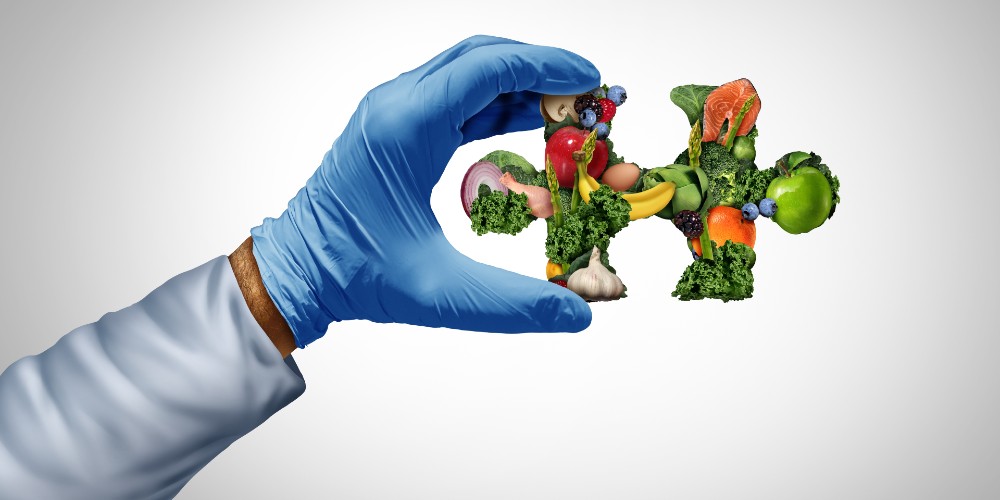- A balanced diet is important for proper nutrition, but many people fall short on essential micronutrients due to consuming energy-dense but nutrient-poor foods
- Micronutrient deficiencies lead to significant health issues like pregnancy complications, weakened immunity and increased risk of diseases
- A recent study published in The Lancet Global Health found that over half of the global population is lacking essential micronutrients, with deficiencies varying by age and gender
- The researchers found that more than 5 billion people are deficient in iodine (68%), vitamin E (67%) and calcium (66%), while over 4 billion lack iron (65%), riboflavin (55%), folate (54%) and vitamin C (53%)
- In the U.S., common nutrient deficiencies include vitamins D, B12, B1, B2, B3, A, C and E, as well as calcium, magnesium and iodine. Tips to address these deficiencies are included below
Food goes beyond providing energy — it’s essential for proper nutrition. Yet, many people fail to get the essential micronutrients they need. The problem often lies in food quality rather than quantity. People are consuming energy-dense, nutrient-poor foods, setting them up for an excess of omega-6 fats from seed oils as well as added sugars, while missing out on vital micronutrients.
Micronutrient deficiencies are a prevalent form of malnutrition, leading to serious consequences like pregnancy complications, weakened immunity and increased risk of diseases. While past studies have investigated nutrient deficiencies and supplies, there has been no comprehensive global assessment of micronutrient intake inadequacies until now.
A recent study published in The Lancet Global Health1 addresses this gap by evaluating whether current intake levels meet recommended health standards, focusing on deficiencies across different ages and genders. Their findings highlight an alarming trend — over half of the global population is deficient in the necessary micronutrients for optimal health.
Global Study Reveals Alarming Widespread Micronutrient Inadequacies
The study,2 conducted by researchers at Harvard T.H. Chan School of Public Health and the University of California, Santa Barbara (UCSB), used data from 31 countries to model global nutrient needs. They applied these models to a dataset from 185 countries, estimating nutrient deficiencies for 99.3% of the world’s population. Fifteen essential nutrients, including calcium, B vitamins and vitamin C, were evaluated across different age and gender groups.
“Our study is a big step forward,” said co-lead author Christopher Free, Ph.D., a research professor at the University of California, Santa Barbara (UCSB), in a news release.3 “Not only because it is the first to estimate inadequate micronutrient intakes for 34 age-sex groups in nearly every country, but also because it makes these methods and results easily accessible to researchers and practitioners.” According to the authors:4
“More than 5 billion people do not consume enough iodine (68% of the global population), vitamin E (67%) and calcium (66%). More than 4 billion people do not consume enough iron (65%), riboflavin (55%), folate (54%) and vitamin C (53%).
Within the same country and age groups, estimated inadequate intakes were higher for women than for men for iodine, vitamin B12, iron and selenium and higher for men than for women for magnesium, vitamin B6, zinc, vitamin C, vitamin A, thiamin and niacin.”
These results underscore the widespread nature of micronutrient deficiencies globally, revealing distinct patterns related to sex and geographic location. “We hope this analysis … improves understanding of global micronutrient inadequacy so that public health interventions can more effectively address deficiencies,” the researchers concluded.
Common Nutrient Deficiencies in the US
According to data from the National Health and Nutrition Examination Surveys (NHANES), an estimated 31% of the U.S. population is at risk of developing one or more micronutrient deficiencies.5 The most common nutrient deficiencies include vitamins D, B1, B2, B3 and B12, A, C, E, calcium, magnesium and iodine.
Although the study didn’t include vitamin D since it primarily focused on nutrients obtained through diet, vitamin D deficiency remains a significant concern in the U.S., impacting approximately 35% of the population.6 Vitamin D is a fat-soluble vitamin that is essential for various physiological functions, including calcium absorption, bone health and immune function.
While it’s found naturally in some foods, your body endogenously produces vitamin D when your skin is exposed to ultraviolet rays from the sun.
However, many factors limit this natural production, including living in northern latitudes, having darker skin, spending most time indoors or using sunscreen. Additionally, as people age, their skin becomes less efficient at producing vitamin D from sun exposure.7
The ideal way to increase your vitamin D levels is through sensible sun exposure. On a typical sunny day,8 your body produces up to 25,000 international units IU of vitamin D. However, it’s important to approach sun exposure with care, especially if your diet is high in seed oils (rich in linoleic acid, or LA).
These oils migrate to your skin and oxidize when exposed to sunlight, causing inflammation and DNA damage, which makes you more prone to sunburn. If you’re on a high-LA diet, I recommend avoiding intense sun exposure until you’ve reduced your seed oil intake for four to six months. As you reduce your LA intake, slowly increase your time outdoors. You’ll eventually be able to enjoy an hour or more during peak sunlight hours.
If you’re unable to get adequate sun exposure, vitamin D3 supplementation is a wise choice. For health and disease prevention, aim for a level between 60 ng/mL and 80 ng/mL. In Europe, the measurements you’re looking for are 150 to 200 nmol/L, respectively.
To determine how much vitamin D3 you need to take, measure your vitamin D level, ideally twice a year. Your ideal dose is whatever it takes to keep you within that 60 ng/mL to 80 ng/mL range. It’s also important to remember that calcium, vitamin D3, magnesium and vitamin K2 must be properly balanced, as these four nutrients work together.
Vitamin B1, B2 and B3
Vitamin B1, also known as thiamine, is used by nearly all your cells and is essential for several functions in the body, including energy production, nerve function, heart health, cognition, digestion and immune function.9
While thiamine deficiency is often the result of alcohol misuse, chronic infections, poor nutrition and/or malabsorption, research suggests vitamin B1 availability has dramatically declined throughout the food chain in recent years,10 and that naturally affects your ability to get sufficient thiamine from your diet.
Adult men and women need 1.2 and 1.1 milligrams (mg), respectively, each day.11 If you have symptoms of thiamine deficiency, you might need higher doses. For tips on how to boost your vitamin B1 levels, I recommend reading my article, “Common Signs of Vitamin B1 Deficiency.”
Similarly, vitamin B2, commonly known as riboflavin, is important for energy production, cellular function and metabolism. As a coenzyme in various redox reactions, riboflavin is essential for converting food into usable energy. It plays a central role in the electron transport chain, where it helps produce ATP, the primary energy source for the body. This makes riboflavin particularly important for overall energy levels and metabolic health.12,13
To increase your riboflavin levels, consume a diet rich in riboflavin sources. Good dietary sources include grass fed dairy products, lean meats like grass fed beef tenderloin, organic low-PUFA eggs, cremini and portabella mushrooms, and green leafy vegetables like spinach and beet greens.
Vitamin B3 exists in two primary forms — niacin (nicotinic acid) and niacinamide (nicotinamide). Both are essential to human health and play important roles in cellular metabolism, converting the food you eat into energy.
These forms of vitamin B3 also serve as precursors for the coenzymes nicotinamide adenine dinucleotide (NAD+) and nicotinamide adenine dinucleotide phosphate (NADP), which are vital for energy production, DNA repair and cell signaling.
For optimal health, I recommend taking 50 mg of niacinamide three times a day. This dosage has been shown to optimize energy metabolism and boost NAD+ levels.
The problem with taking too much vitamin B3, whether in the form of niacin or niacinamide, is that it might backfire and contribute to cardiovascular disease as demonstrated in a study conducted by the Cleveland Clinic.14 I talked more about this in my article, “Vitamin B3 Boosts Muscle Mass, Improves Glucose Control.” As for food sources, vitamin B3 is found in grass fed beef and beef liver, bananas and mushrooms.15
Vitamin B12
Also known as cobalamin, vitamin B12 is a water-soluble vitamin that plays a role in numerous biochemical reactions and neurological functions in your body, including DNA synthesis. Your body can’t make vitamin B12 on its own, so it must be obtained via your diet or supplementation.16
According to NHANES data, about 3.6% of U.S. adults aged 19 and older have a vitamin B12 deficiency, with the rate slightly increasing to 3.7% in those 60 and older. However, vitamin B12 insufficiency is more common, affecting around 12.5% of adults aged 19 and older and 12.3% of those 60 and older. During pregnancy, vitamin B12 levels often decrease, sometimes falling below normal levels.17
Vitamin B12 is found almost exclusively in animal foods, such as grass fed beef and beef liver, lamb, organic eggs and grass fed dairy products. The few plant foods that are sources of B12 are actually B12 analogs that block the uptake of true B12, so do not make the mistake of thinking you can rely on vegan sources for all your B12 needs.
If you rarely eat the foods listed, consider using nutritional yeast. It’s high in B12 and has a cheesy flavor that works well on any number of dishes. One 16-gram serving (just over 2 tablespoons) provides 24 micrograms of natural vitamin B12.18 Advancing age diminishes your body’s ability to absorb B12 from food, so you might want to consider supplementation as you get older.19
Vitamins A and C
An estimated 51% of adults are not consuming enough vitamin A,20 increasing their risk of degenerative diseases like macular degeneration, a leading cause of blindness in the U.S.21 Vitamin A is also responsible for immune system function as well as cellular growth and differentiation.22
Vitamin A is a group of nutrients that falls into two different categories — retinoids found in animal foods and carotenoids found in plant foods. The two are chemically different and provide different health benefits, but both are necessary for optimal health. Plant foods high in beta-carotene include sweet potatoes, carrots, cantaloupe and mangoes. Animal foods rich in vitamin A include liver, egg yolks and grass fed butter.23
Vitamin C, also known as ascorbic acid, is known for its potent antioxidant properties and role in numerous bodily functions, including tissue growth and repair, collagen synthesis, iron absorption and immune function.24
A wide variety of foods are high in vitamin C, including red pepper, parsley, broccoli, kiwi, strawberries, guava, tomato and all citrus fruits. You’ll get significant amounts of vitamin C from your diet if you eat these foods on a daily basis.
In addition to dietary sources, I highly recommend keeping liposomal vitamin C in your medicine cabinet, particularly for acute viral illnesses. If I were to become acutely ill, I would take 4 grams of liposomal vitamin C every hour until feeling better, then start decreasing the dosage slowly over a few days once symptoms improve.
Vitamin E
Vitamin E is a fat-soluble vitamin with potent antioxidant properties, protecting your cells from free radical damage. It also supports the production of red blood cells, regulates your body’s use of vitamin K (which is important for heart health) and is involved in your immune function and cell signaling.25 Additionally, it protects your body against damage caused by linoleic acid and estrogen.
In the U.S. alone, approximately 88.5% of the population fails to reach the recommended dietary allowance (RDA) of vitamin E.26 To increase vitamin E levels, eat foods rich in this nutrient, including spinach, pumpkin, asparagus, red bell peppers, tomatoes, kiwi and mango.27
Some health authorities recommend vegetable oils, seeds and nuts as good sources,28 but these are actually terrible due to their high LA content. Beans — another good source of vitamin E — are also problematic for many due to their high lectin content.
Supplementation is also an option to increase your levels, but it’s important to look for a real vitamin E supplement and not synthetic. What you’re looking for is “d alpha tocopherol.” I go into detail about this in “Vitamin E Helps Decrease Your Cancer Risk.”
Calcium and Magnesium
Over 40% of the U.S. population fails to meet their calcium needs through diet alone, putting them at increased risk of bone-related issues such as osteoporosis and fractures.29 Calcium is also essential for muscle contraction, nerve transmission and blood clotting.30
A deficiency in calcium coupled with excess phosphorus intake due to phosphate additives in processed food poses additional risk, as it disrupts your calcium-to-phosphorus ratio, which leads to calcification of the vascular system and cardiovascular problems.31
Some good dietary sources of calcium to increase your levels include grass fed dairy products like yogurt, milk and cheese made from animal rennet. Some vegetables contain this mineral as well, such as collard greens, spinach, turnip greens, kale, cooked taro root and bok choy.32
Estimates suggest that over half of the U.S. population also aren’t getting enough magnesium from their diet.33 While the minimum amount needed to avoid deficiency is about 150 to 180 milligrams per day, optimal levels are closer to 600 milligrams per day. For reference, the RDA ranges from 310 to 420 milligrams per day, depending on age and sex.34
Some good dietary sources of magnesium include dark chocolate, leafy greens, potatoes (peeled and boiled) and plain organic yogurt, to name a few. Avocados are also commonly recommended as a good source of this mineral, but they’re high in monounsaturated fat (MUFAs), which harms your metabolic function if consumed in excess.
Iodine
Iodine is an essential trace mineral that plays a role in the production of thyroid hormones, which regulate metabolism, growth and development. Adequate iodine intake is vital for maintaining healthy thyroid function and reducing the risk of disorders such as goiter and hypothyroidism. In addition, iodine is important for healthy bone and brain development during pregnancy and infancy.35
Foods that contain higher amounts of iodine include sea vegetables, such as kelp, kombu and wakame.36 Kelp has the highest amount of any food and just one serving gives you four times the recommended daily allowance. Organic, grass fed butter is another good source of iodine. Iodized salt also increases your levels if you don’t avoid eating it in the mistaken belief that it’s bad for your heart.
Will Taking a Multivitamin Help with Nutrient Deficiencies?
A diet rich in whole, nutrient-dense foods is key to avoiding nutrient deficiency. However, multivitamins help address gaps if you’re not eating right or if you suspect you have deficiencies. Research37 from Oregon State University found that older men who took multivitamins showed improved nutritional biomarkers compared to those who took a placebo.
In fact, some participants in the placebo group had decreased nutrition markers, indicating that diet alone might not be sufficient, particularly for maintaining vitamin and carotenoid levels.38 Multivitamins also benefit memory in older adults. One study39 found that daily use could improve memory performance comparable to reversing about three years of age-related decline compared to a placebo.
If you’re planning to take multivitamins, it’s generally recommended to take half your daily dose in the morning, with breakfast, and the other half with your main meal. Remember, though, that multivitamins should complement, not replace, a healthy diet.
Dietary supplements are meant to support a balanced lifestyle, not substitute for it. Consider consulting with a holistic health professional to identify specific nutrient deficiencies and tailor your supplement and food choices to address them.
- 1, 2, 4 Lancet Glob Health. 2024 Aug 29:S2214-109X(24)00276-6
- 3 EurekAlert! August 29, 2024
- 5 The Institute of Functional Medicine, The Hidden Hunger: Micronutrient Deficiencies
- 6 StatPearls [Internet]. Vitamin D Deficiency
- 7 Endocrine. 2023; 79(1): 31–44
- 8 Journal of Steroid Biochemistry and Molecular Biology, 2019;189
- 9 Biosci Rep. 2023 Oct 31;43(10):BSR20230374
- 10 The Science Times January 31, 2021
- 11 NIH Thiamin, February 9, 2023
- 12 NIH ODS, Riboflavin
- 13 StatPearls [Internet]. Biochemistry, Oxidative Phosphorylation
- 14 Nature Medicine volume 30, pages 424–434 (2024)
- 15 Harvard T.H. Chan School of Public Health, Niacin – Vitamin B3
- 16 StatPearls [Internet]. Vitamin B12 (Cobalamin)
- 17 Harvard T.H. Chan School of Public Health, Riboflavin — Vitamin B2
- 18 USDA FoodData Central, Nutritional Yeast
- 19 The New York Times, Vitamin B12 as Protection for the Aging Brain
- 20 Oregon State University, Micronutrient Inadequacies, Vitamin A
- 21 Front Nutr. 2022; 9: 914457
- 22, 23 NIH ODS, Vitamin A and Carotenoids
- 24 StatPearls [Internet]. Vitamin C (Ascorbic Acid)
- 25, 28 NIH ODS, Vitamin E
- 26 USA Today, April 1, 2023
- 27 HSPH, Vitamin E
- 29 Oregon State University, Micronutrient Inadequacies in the US Population: an Overview
- 30 StatPearls [Internet]. Physiology, Calcium
- 31 Arterioscler Thromb Vasc Biol. 2024 Mar;44(3):584-602
- 32 Dietary Guidelines for Americans, Food Sources of Calcium
- 33 Oregon State University, Micronutrient Inadequacies (Magnesium)
- 34 National Institutes of Health, Magnesium
- 35, 36 NIH ODS, Iodine
- 37 Nutrients 2023, 15(12), 2691; doi: 10.3390/nu15122691
- 38 Oregon State University June 14, 2023
- 39 The American Journal of Clinical Nutrition July 2023, Volume 118, Issue 1, Pages 273-282, Results
-
Learn the TRUTH about Gold IRAs and how most precious metals companies play dirty.




